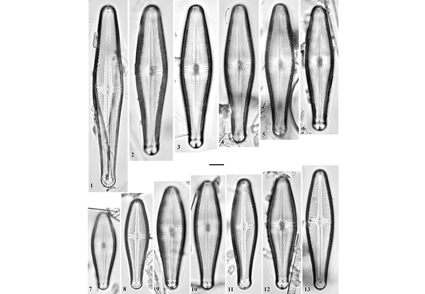Abstract
This note describes a new record of Gomphonema firmum Skvortzow, which expanded both morphological and distributional ranges of the species. This conspicuous diatom was previously unknown outside of Lake Baikal, where it inhabits deep-water areas. The newly discovered locality belongs to a small stream at a distance of 180 km west from Lake Baikal, where the species was found in a relatively high abundance that enabled to trace a size diminution series including specimens shorter than previously described. In addition, G. lanceolatum var. maximum Poretzky, a name for a diatom from Lake Teletskoe, was included in a synonymy of G. firmum that further expanded the species distribution. In the light of the presented data, the species appears to be a rare diatom with current distribution limited to a few scattered localities in southern Siberia.
References
<p>Bondarenko, N.A. & Genkal, S.I. (2005) On the records of Lake Baikal endemic algae in mountains lakes of Zabaikalye. <em>Botanicheskii Zhurnal</em> 90 (9): 1389–1401.</p>
<p>Ehrenberg, C.G. (1832) Über die Entwickelung und Lebensdauer der Infusionsthiere; nebst ferneren Beiträgen zu einer Vergleichung ihrer organischen Systeme. <em>Abhandlungen der Königlichen Akademie Wissenschaften zu Berlin, Physikalische Klasse</em> 1831: 1–154.</p>
<p>Ehrenberg, C.G. (1843) Verbreitung und Einfluss des mikroskopischen Lebens in Süd- und Nord-Amerika. <em>Abhandlungen der Königlichen Akademie der Wissenschaften zu Berlin 1841</em>: 291–445.</p>
<p>Flower, R.J. (2005) A review of diversification trends in diatom research with special reference to taxonomy and environmental applications using examples from Lake Baikal and elsewhere. <em>Proceedings of the California Academy of Sciences</em> 56 (11): 107–128.</p>
<p>Genkal, S.I. & Bondarenko, N.A. (2006) Are the Lake Baikal diatoms endemic? <em>Hydrobiologia</em> 568 (S): 143–153. https://doi.org/10.1007/s10750-006-0321-y</p>
<p>Krammer, K. & Lange-Bertalot, H. (1986) Bacillariophyceae, 1. Teil: Naviculaceae.<em> In: </em>Ettl, H., Gerloff, J., Heynig, H. & Mollenhauer, D. (Eds.) <em>Süsswasserflora von Mitteleuropa. Band 2/1</em>. Gustav Fischer Verlag, Jena, pp. 1–876.</p>
<p>Kulikovskiy, M. & Kociolek, J.P. (2014) The diatom genus <em>Gomphonema</em> Ehrenberg in Lake Baikal. I. Morphology and taxonomic history of two endemic species. <em>Nova Hedwigia, Beiheft</em> 143: 507–518. https://doi.org/10.1127/1438-9134/2014/027</p>
<p>Kulikovskiy, M.S., Glushchenko, A.M., Genkal, S.I., Kuznetsova, I.V. & Kociolek, J.P. (2020) <em>Platebaikalia </em>– a new monoraphid diatom genus from ancient Lake Baikal with comments on the genus <em>Platessa</em>. <em>Fottea, Olomouc</em> 20: 58–67. https://doi.org/10.5507/fot.2019.014</p>
<p>Kulikovskiy, M.S., Lange-Bertalot, H., Metzeltin, D. & Witkowski, A. (2012) Lake Baikal: hotspot of endemic diatoms. I. <em>Iconographia Diatomologica. Annotated diatom micrographs</em> 23: 7–608.</p>
<p>Levadnaja, G.D. (1973) Species nova et rarae Bacillariophytorum in flumine Enissej. <em>Novosti sistematiki nizshikh rastenii</em> 10: 18–21.</p>
<p>Levkov, Z. (2009) <em>Amphora</em> sensu lato. <em>Diatoms of Europe: Diatoms of the European inland waters and comparable habitats</em> 5: 5–916.</p>
<p>Mats, V.D. (1993) The structure and development of the Baikal rift depression. <em>Earth-Science Reviews</em> 34 (2): 81–118. https://doi.org/10.1016/0012-8252(93)90028-6</p>
<p>Metzeltin, D. & Lange-Bertalot, H. (2014) The genus <em>Didymosphenia</em> M. Schmidt. A critical evaluation of established and description of 11 new taxa. <em>Iconographia Diatomologica.</em> <em>Annotated diatom micrographs</em> 25: 1–293.</p>
<p>Pomazkina, G., Rodionova, Ye., Sherbakova, T. & Williams, D.M. (2016) <em>Petroplacus gen. nov.</em> (<em>Bacillariophyta</em>): a new genus of diatom from Lake Baikal. <em>Phytotaxa</em> 272: 267–276. https://doi.org/10.11646/phytotaxa.272.4.4</p>
<p>Pomazkina, G.V., Rodionova, E.V. & Sherbakova, T.A. (2019) Validation of 123 names of new diatom taxa from Lake Baikal. <em>Limnology and Freshwater Biology </em>1: 181–198. https://doi.org/10.31951/2658-3518-2019-A-1-181</p>
<p>Poretzky, V.S. & Sheshukova, V.S. (1953) Diatomovye Teletskogo ozera i svyazannykh s nim rek.<em> In: </em>Proschkina-Lavrenko, A.I. & Sheshukova, V.S. (Eds.) <em>Diatomovyi sbornik</em>. Izdatelstvo Leningradskogo Universiteta, Leningrad, pp. 107–172.</p>
<p>Proschkina-Lavrenko, A.I. (Ed.) (1950) <em>Diatomovyi Analiz. Kniga 3. Opredelitel iskopaemykh i sovremennykh diatomovykh vodoroslei. Poryadok Pennales</em>. Gosgeolitizdat, Leningrad, 398 pp. 117 pls.</p>
<p>Reichardt, E. (1995) Die Diatomeen (Bacillariophyceae) in Ehrenbergs Material von Cayenne, Guyana Gallica (1843). <em>Iconographia Diatomologica</em> 1: 1–99.</p>
<p>Rodionova, Y., Pomazkina, G. & Sherbakova, T. (2019) Three new diatom species of the genus <em>Diploneis</em> (Bacillariophyta) from Lake Baikal. <em>Diatom Research</em> 34 (2): 95–108. https://doi.org/10.1080/0269249X.2019.1620339</p>
<p>Skabitschewsky, A.P. (1963) Vodorosli nekotorykh vodoemov okrestnostei Irkutska.<em> In: </em>Galaziy, G.I. (Ed.) <em>Issledovaniya po mikroflore i zooplanktonu Baikala </em>(<em>Trudy Limnologicheskogo Instituta</em> 22). Izdatelstvo Akademii nauk SSSR, Moscow, Leningrad, pp. 48–62.</p>
<p>Skabitschewsky, A.P. (1984) Species Gomphonematis Ag. (Bacillariophyta) Lacus Baical. <em>Novosti sistematiki nizshikh rastenii</em> 21: 51–62.</p>
<p>Skvortzow, B.W. & Meyer, K.I. (1928) A contribution to the Diatoms of Baikal Lake. <em>Proceedings of the Sungaree River Biological Station</em> 1 (5): 1–55.</p>
<p>Skvortzow, B.W. (1937) Bottom diatoms from Olhon Gate of Baikal Lake, Siberia. <em>Philippine Journal of Science</em> 62 (3): 293—377.</p>
<p><em>T</em>he INTAS Project 99-1669 Team (2002) <em>A new bathymetric map of Lake Baikal</em>. Open-File Report on CD-Rom.</p>
<p>Usoltseva, M., Kopyrina, L., Titova, L., Morozov, A., Firsova, A., Zakharova, Y., Bashenkhaeva, M., Maslennikova, M. & Likhoshway, Y. (2020) Finding of a putative Lake Baikal endemic, <em>Lindavia minuta</em>, in distant lakes near the Arctic pole in Yakutia (Russia). <em>Diatom Research</em> 35 (2): 141–153. https://doi.org/10.1080/0269249X.2020.1747551</p>
<p>Vishnyakov, V.S. & Romanov, R.E. (2015) Typification of the name <em>Gomphonema popovae</em> (Bacillariophyceae). <em>Botanicheskii Zhurnal</em> 100 (4): 382–388. https://doi.org/10.1134/S0006813615040067</p>


